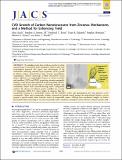| dc.contributor.author | Kudo, Akira | |
| dc.contributor.author | Steiner, Stephen A. | |
| dc.contributor.author | Bayer, Bernhard C. | |
| dc.contributor.author | Kidambi, Piran R. | |
| dc.contributor.author | Hofmann, Stephan | |
| dc.contributor.author | Strano, Michael S. | |
| dc.contributor.author | Wardle, Brian L. | |
| dc.date.accessioned | 2015-06-03T16:21:56Z | |
| dc.date.available | 2015-06-03T16:21:56Z | |
| dc.date.issued | 2014-12 | |
| dc.date.submitted | 2014-09 | |
| dc.identifier.issn | 0002-7863 | |
| dc.identifier.issn | 1520-5126 | |
| dc.identifier.uri | http://hdl.handle.net/1721.1/97179 | |
| dc.description.abstract | By excluding metals from synthesis, growth of carbon nanostructures via unreduced oxide nanoparticle catalysts offers wide technological potential. We report new observations of the mechanisms underlying chemical vapor deposition (CVD) growth of fibrous carbon nanostructures from zirconia nanoparticles. Transmission electron microscope (TEM) observation reveals distinct differences in morphological features of carbon nanotubes and nanofibers (CNTs and CNFs) grown from zirconia nanoparticle catalysts versus typical oxide-supported metal nanoparticle catalysts. Nanofibers borne from zirconia lack an observable graphitic cage consistently found with nanotube-bearing metal nanoparticle catalysts. We observe two distinct growth modalities for zirconia: (1) turbostratic CNTs 2–3 times smaller in diameter than the nanoparticle localized at a nanoparticle corner, and (2) nonhollow CNFs with approximately the same diameter as the nanoparticle. Unlike metal nanoparticle catalysts, zirconia-based growth should proceed via surface-bound kinetics, and we propose a growth model where initiation occurs at nanoparticle corners. Utilizing these mechanistic insights, we further demonstrate that preannealing of zirconia nanoparticles with a solid-state amorphous carbon substrate enhances growth yield. | en_US |
| dc.description.sponsorship | United States. Army Research Office (Contract W911NF-13-D-0001) | en_US |
| dc.language.iso | en_US | |
| dc.publisher | American Chemical Society (ACS) | en_US |
| dc.relation.isversionof | http://dx.doi.org/10.1021/ja509872y | en_US |
| dc.rights | Creative Commons Attribution License | en_US |
| dc.rights.uri | http://creativecommons.org/licenses/by/4.0/ | en_US |
| dc.source | ACS | en_US |
| dc.title | CVD Growth of Carbon Nanostructures from Zirconia: Mechanisms and a Method for Enhancing Yield | en_US |
| dc.type | Article | en_US |
| dc.identifier.citation | Kudo, Akira, Stephen A. Steiner, Bernhard C. Bayer, Piran R. Kidambi, Stephan Hofmann, Michael S. Strano, and Brian L. Wardle. “CVD Growth of Carbon Nanostructures from Zirconia: Mechanisms and a Method for Enhancing Yield.” Journal of the American Chemical Society 136, no. 51 (December 24, 2014): 17808–17817. © 2014 American Chemical Society | en_US |
| dc.contributor.department | Massachusetts Institute of Technology. Department of Aeronautics and Astronautics | en_US |
| dc.contributor.department | Massachusetts Institute of Technology. Department of Chemical Engineering | en_US |
| dc.contributor.department | Massachusetts Institute of Technology. Department of Materials Science and Engineering | en_US |
| dc.contributor.mitauthor | Kudo, Akira | en_US |
| dc.contributor.mitauthor | Steiner, Stephen A. | en_US |
| dc.contributor.mitauthor | Strano, Michael S. | en_US |
| dc.contributor.mitauthor | Wardle, Brian L. | en_US |
| dc.relation.journal | Journal of the American Chemical Society | en_US |
| dc.eprint.version | Final published version | en_US |
| dc.type.uri | http://purl.org/eprint/type/JournalArticle | en_US |
| eprint.status | http://purl.org/eprint/status/PeerReviewed | en_US |
| dspace.orderedauthors | Kudo, Akira; Steiner, Stephen A.; Bayer, Bernhard C.; Kidambi, Piran R.; Hofmann, Stephan; Strano, Michael S.; Wardle, Brian L. | en_US |
| dc.identifier.orcid | https://orcid.org/0000-0003-3506-9924 | |
| dc.identifier.orcid | https://orcid.org/0000-0003-3530-5819 | |
| dc.identifier.orcid | https://orcid.org/0000-0003-2944-808X | |
| mit.license | PUBLISHER_CC | en_US |
| mit.metadata.status | Complete | |
